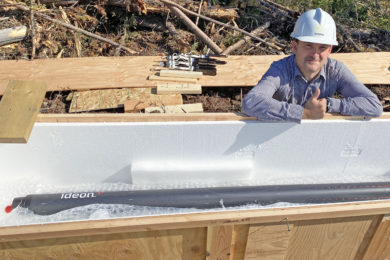Canada-based Earth ‘X-ray’ start-up, Ideon Technologies, and Orano Group, one of the world’s top uranium producers, have deployed the world’s first cosmic-ray muon detector for use in industry-standard boreholes.
The EUREKA-approved research and development project, which is receiving advisory services and funding support from the National Research Council of Canada Industrial Research Assistance Program, will run from now through the end of 2021 at McClean Lake, an Orano uranium site in northern Saskatchewan, Canada.
Ideon says it is a pioneer in muon tomography, providing X-ray-like imaging up to 1 km beneath the Earth’s surface. The Ideon discovery platform integrates proprietary muon detectors, imaging systems, inversion technologies, and artificial intelligence to produce high-resolution 3D density maps of underground targets, it explained.
Orano’s imaging target is a high-grade, compact uranium deposit located at 300 m depth. Multiple borehole muon detectors are deployed down a single drill hole in a connected sequence, delivering progressive imaging results throughout the survey.
Orano and Ideon have been collaborating since 2016, when Ideon deployed its first-generation, large-format detectors at the McArthur River uranium mine in Saskatchewan, successfully imaging a high-grade uranium deposit under 600 m of sandstone. Since then, Ideon has completed a 50 times miniaturisation effort to create the first industry-standard borehole (<100 mm diameter), low-power (<10 W continuous power consumption), zero-maintenance muon tomography detector suitable for operation in the extreme environmental conditions of mineral exploration sites around the world, the company explained.
“We’re excited to move forward on this project with Ideon because we expect it to transform the very nature of how we explore,” Hervé Toubon, Research & Development and Innovation Director at Orano Mining, said. “Global uranium demand is projected to grow by up to 40% by 2025 and it is virtually impossible for us to detect high-grade deposits at depth using traditional geophysical exploration techniques. The subsurface intelligence we gain with muon tomography gives us the ability to accurately locate those anomalies while reducing the need for drilling and lowering our overall environmental impact. That value proposition is hard to beat.”
Gary Agnew, CEO at Ideon, said: “This deployment milestone is more than a decade in the making. We’ve spent seven years doing commercial trials in partnership with the mining industry and several years of system design and development, de-risking, and prototyping in the lab. Orano has been there right along with us for much of that journey, leading the way as a customer-driven innovator in the global energy transition. We are grateful for their enthusiasm, flexibility, trust, and willingness to break new ground with us.”
In addition to muon tomography models, Ideon will work with Orano to develop joint inversions with existing drill data and other geophysical datasets.
Ideon is currently implementing an exclusive early access program for borehole muon tomography. The company claims it is the only straight-line subsurface imaging technology available today, delivering the highest available resolution along with precise anomaly location information. Muon tomography uses a passive and free energy source (cosmic rays from space), offers the ability to image in noisy or conductive environments, and captures data continuously – improving imaging results over time, the company said.










